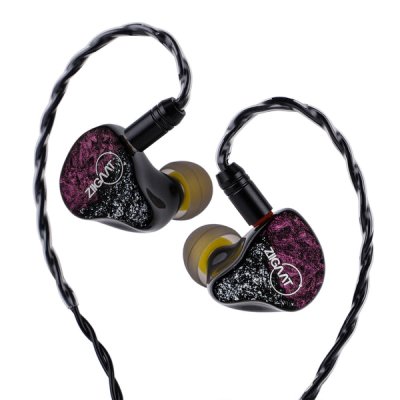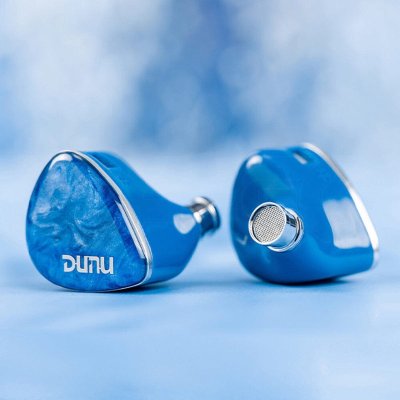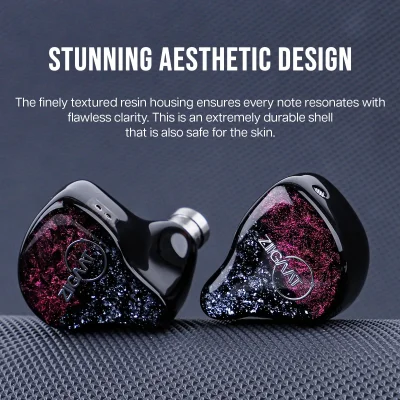Ziigaat Odyssey and Dunu 142 use 1DD+3BA and 1DD+4BA+2Planar driver setups respectively. Ziigaat Odyssey costs $229 while Dunu 142 costs $249. Dunu 142 is $20 more expensive. Dunu 142 holds a slight 0.3-point edge in reviewer scores (7.8 vs 8.1). Ziigaat Odyssey carries a user score of 7.4. Ziigaat Odyssey has slightly better bass with a 0.4-point edge, Ziigaat Odyssey has better mids with a 0.8-point edge, Dunu 142 has slightly better treble with a 0.3-point edge and Dunu 142 has slightly better dynamics with a 0.4-point edge.
Insights
| Metric | Ziigaat Odyssey | Dunu 142 |
|---|---|---|
| Bass | 7.6 | 7.2 |
| Mids | 8.1 | 7.3 |
| Treble | 7.4 | 7.7 |
| Details | 7.2 | 7.4 |
| Soundstage | 7.5 | 7.5 |
| Imaging | 7.8 | 7.5 |
| Dynamics | 7.3 | 7.7 |
| Tonality | 7.8 | 7.7 |
| Technicalities | 7.1 | 7.8 |
Ziigaat Odyssey Aggregated Review Score
Average Reviewer Scores
Average Reviewer Score:
7.8Strongly Favorable
Dunu 142 Aggregated Review Score
Average Reviewer Scores
Average Reviewer Score:
8.1Very Positive
Reviews Comparison
Ziigaat Odyssey reviewed by Jaytiss
Youtube Video Summary
The ZiiGaat Odyssey combines a familiar but comfortable shell with a genuinely fantastic sound signature for its price. The resin body is a bit on the thick side, but the metal nozzle grips tips securely, isolation is good, and the flat 2-pin connector makes cable swapping easy. Its silver-and-magenta faceplate looks premium and eye-catching, while the standard ZiiGaat case is practical and protective, if not particularly exciting. Accessories overall feel a bit sparse, so the focus here is clearly on the IEM itself rather than the extras.
Sonically, the Odyssey delivers a very balanced and engaging presentation: ample bass for most listeners, nicely elevated upper mids, and a smooth, clean treble that avoids harshness. It stands out as one of the better tuned IEMs under $300, with a flat, even tonality that feels cohesive and versatile across genres. The mids are a real strength, with good note weight and a natural sense of body, and the bass is fun without becoming bloated. Technical performance is good but not groundbreaking – soundstage and imaging feel appropriate for the price rather than jaw-dropping, and the upper treble can lack a bit of the “pristineness” some might want.
Within ZiiGaat’s own lineup and its price bracket, Odyssey sits as a strong all-rounder. It is more open and extended than sets like the Arcadia or Ceno, more neutral and controlled than the more energetic Dinko, and trades blows well with alternatives such as Jay’s Australa, AFUL P7, K4 and Dunu Quattro. Among those, Quattro feels like the best pure tuning, P7 the most technically capable, while Odyssey arguably offers the most balanced mix of everyday usability and enjoyment. With a score of 8.8/10 and very competitive price-to-performance—especially when discounts are in play—the ZiiGaat Odyssey comes across as a genuinely impressive mid-tier option with only minor caveats in its treble refinement and accessory package.
Jaytiss Youtube Channel
Buy Ziigaat Odyssey on Linsoul
Ad
Price: $229
Buy Ziigaat Odyssey on Linsoul
Dunu 142 reviewed by Jaytiss
Youtube Video Summary
The Dunu 142 comes in as a striking one dynamic driver, four BA, two planar tribrid around the $250 mark, pairing a sapphire-like blue shell with excellent ergonomics and isolation. The fully blue faceplate catches the light beautifully, the shell is vented yet comfortable, and the build includes a slightly recessed 2-pin connector that feels robust and well thought out. Accessories are strong too: a familiar but well-made Dunu case, a solid tip selection, cleaning tool, and a premium-feeling modular cable with working chin slider and swappable terminations like 4.4 and 3.5 (with optional USB-C from Dunu directly), rounding out a package that feels both premium and cohesive.
Sonically, this is a sub-bass focused set with a slight W-shaped character, offering plenty of low-end, flat and clean mids, and energetic upper treble that keeps things exciting without turning harsh. It is not a mid-bass-heavy IEM and can come across as a bit cool or thin to those who prefer warmer tunings, but the sub-bass impact and air make it engaging and fun, especially for rock, metal and modern pop. Female vocals in particular tend to shine thanks to the scooped middle that keeps things clear and uncluttered, while the treble stays pristine, clean, and non-sibilant. Technical performance is strong, with a wide, open stage, good imaging and satisfying micro-detail, evoking comparisons to higher-end sets like the Monarch MK4 while refining aspects of other Dunu models and peers such as Da Vinci, DK3001, Brain Dance, Ziigaat Horizon, AFUL P7 and various ZiiGaat and Punch Audio offerings.
In the crowded sub-$300 space, the Dunu 142 is framed as a new benchmark: bass is scored around a strong nine, mids an eight with their flat, well-executed character, and treble praised for clarity and extension while remaining controlled. It competes closely with sets like Astral and Daybreak and sits alongside favorites such as Punch Audio Martillo and Ziigaat models, yet distinguishes itself with its balance of impactful sub-bass, airy treble and refined tonality. Despite a touch of lean character that may not suit die-hard warmth lovers, it earns a place on a tightly curated five-star list under $500—one IEM per brand—thanks not only to its sound but also its packaging, cable, case and overall presentation, making it a genuinely special, potentially endgame choice for many who want to grab one beautiful, resolving set and be done.
Jaytiss Youtube Channel
Buy Dunu 142 on HiFiGO
Ad
Price: $249
Buy Dunu 142 on HiFiGO
Ziigaat Odyssey reviewed by Web Search
The Ziigaat Odyssey offers a balanced take on the popular Meta tuning, emphasizing sub-bass rumble while maintaining a clean midrange. Its bass provides satisfying depth without bleeding into the mids, making genres like electronic or hip-hop engaging. Vocals come through clearly and naturally, though some listeners might find them lacking a touch of emotional expressiveness or "magic" compared to more specialized sets . The treble is generally smooth and inoffensive, avoiding harshness but sacrificing some sparkle and micro-detail retrieval .
Technically, the Odyssey presents a wider-than-average soundstage, though depth and height are more modest. Instrument separation handles moderately complex tracks competently but can struggle with dense passages. Its strength lies in its cohesive driver integration and natural timbre, minimizing typical BA artifacts . Comfort is good for most despite the resin shells, but isolation is average due to the venting design. The included accessories, particularly the stiff silicone tips and non-modular cable, are weak points for the price .
Overall, the Odyssey is a versatile performer prioritizing enjoyable tonality and listenability over technical brilliance. It's an easy recommendation for those seeking a well-tuned, non-fatiguing hybrid around $200, especially if tip rolling is employed. However, detail enthusiasts or those needing maximum isolation might look elsewhere .
Dunu 142 reviewed by Web Search
The DUNU DN142 is a seven-driver tribrid IEM built around a 1DD + 4BA + 2 micro-planar configuration, positioned at roughly $249 MSRP in the mid-fi segment. The lightweight 3D-printed resin shells (about 5.6 g per side) and Q-Lock modular cable system aim for comfort and flexibility rather than luxury flair, while specifications such as a 5 Hz–40 kHz claimed frequency range, 37 Ω impedance, and 107 dB/mW sensitivity suggest an IEM that is reasonably easy to drive but not ultra-sensitive. Overall build quality appears solid and functional, with the design language focused on the Ao Bing “deep ocean” theme rather than metal housings or ornate embellishments.
Sonically, the DN142 is described as a more relaxed, warm-leaning alternative to DUNU’s brighter DN242, with a slightly elevated mid-bass, a comfortable, rounded midrange, and less forceful sub-bass and upper-treble energy. Community impressions further characterize it as having a broadly balanced, studio-monitor style tuning with a touch of warmth: mid-bass sits slightly above sub-bass, mids are smooth and natural, and treble is present yet controlled rather than sharp or aggressive. This profile should suit listeners who prioritise long-term comfort and organic vocals over maximum sparkle or sub-bass impact, while bass-heads and those seeking a highly energetic treble presentation may find it too restrained.
In terms of technical performance, the DN142’s tribrid driver array and four-way crossover deliver good resolution, layering and imaging for its price, with multiple early impressions noting “a ton of performance on tap” and clean separation even with more complex material. Staging and dynamics appear competitive but not class-defining compared with higher-priced tribrids; the presentation leans more towards controlled, coherent and slightly intimate than vast or dramatically punchy. Taken together, the DN142 offers a warm-neutral, easy-listening tuning with solid technicalities that feels fairly priced in the ~$250 bracket, delivering good but not “end-game” performance relative to much more expensive flagships.
Ziigaat Odyssey (more reviews)
Ziigaat Odyssey reviewed by Bad Guy Good Audio
Bad Guy Good Audio original ranking
Bad Guy Good Audio Youtube ChannelZiigaat Odyssey reviewed by Audio Amigo
Youtube Video Summary
Ziigaat Odyssey comes in at $230 with a four-driver hybrid (1DD + 3 BAs) that’s very easy to drive. Build is the usual Ziigaat: full 3D-printed resin shells with metal nozzles and filters; sturdy and comfortable for average-to-larger ears, while tiny ears get a technical pass. The weak spot is the accessories: a basic cable (3.5mm or 4.4 option), one set of soft silicone tips plus foams, and a leatherette case that feels flimsy—underwhelming at this price. Aesthetics score well with a sparkly faceplate that the “Council of Ladies” mostly favors, even if it doesn’t always trigger compliments.
Sonically, Odyssey aims for warm-neutral with a tasteful bass boost. Sub-bass texture can run a touch soft, but mid-bass punch is addicting, giving kick drums and bass guitars real drive without boom. Lower mids are warm and slightly veiled in a pleasant, retro-leaning way; female vocals sit a bit back yet remain clean. Treble is safe but present—enough sparkle and clarity to balance the bass without sting, though true treble-heads may want more air. Technicals are solid for the bracket: good resolution, excellent separation, precise imaging, and an average-sized but convincing stage. With a 15–30Ω adapter, the FR tilts more V-shaped (more bass/upper-mids/treble), a fun twist for occasional variety.
Against peers, Odyssey is the relaxed, safer listen: warmer and less contrasty than EPZ P50 (brighter, more vocal-forward) and Kiwi Ears K4 (more V-shaped excitement), and a middle ground between AFUL Explorer (darker, bassier) and AFUL Performer 5+2 (airier, more resolving with stronger female vocals). Not the pick for bass-heads, treble-heads, or libraries packed with K-/J-pop divas, but a killer one-and-done all-rounder for mixed libraries that value warmth, balance, and zero fatigue. Despite the skimpy pack-ins, the tuning and performance earn a spot in “this is brilliant.”
Audio Amigo Youtube Channel
Ziigaat Odyssey reviewed by Paul Wasabii
Youtube Video Summary
A slow-burn hybrid (1DD + 3BA) around $200 that has grown by word of mouth. Tuning is Goldilocks—smoother/warm lower end with a tidier, slightly lifted upper end—making it broadly natural and low-fatigue across libraries. Impedance interaction matters: low-impedance sources keep a fuller mid-bass and flatter ~5 kHz, while added impedance nudges sub-bass and a little 5 kHz bite for a more U-shaped tilt. It doesn’t chase max technicalities, instead prioritizing musicality and tone.
Bass leans mid-bass over pure sub-bass, bringing welcome physicality and punch without boom; the custom DD feels lively. Mids are clean yet set a hair behind bass/treble, so transparency and headline resolution trail leaner micoplanar-leaning rivals, but timbre stays convincing and unfussy. Treble rides the line—polished and slightly elevated to balance the low end, with potential ~5 kHz energy on higher-impedance chains—still more smooth than sharp. Stage, depth and air are as expected for the class, yielding a coherent, well-balanced presentation that explains its long-tail appeal.
Paul Wasabii Youtube Channel
Ziigaat Odyssey reviewed by Jays Audio
Youtube Video Summary
Ziigaat Odyssey lands as a mid-range focused set with a slight treble lift that really scales with volume. At relaxed levels it’s clean, calm, and easygoing; turn it up and the presentation becomes wide, airy, and immersive with a surprisingly punchy, rumbly low end for its graph. The new topology DD hits a sweet balance—neither sluggish nor hyper-snappy—delivering well-balanced bass that serves the tuning, even if ultimate slam/texture trails sets like Hype 4 or Xenns Tea Pros. Tip rolling toward slightly brighter tips adds a touch of treble energy and liveliness without pushing fatigue.
The star here is the midrange: instruments layer neatly with comfortable separation, and vocals sit clean and natural—not shouty, not veiled—though they can feel a bit too relaxed at mid volume. Treble is smooth yet detailed, revealing cymbal micro-info and air without harshness, and it’s noticeably cleaner than Explorer while avoiding metallic timbre. Technicals are solid for the price—a step up from Explorer and just behind “contet” in raw resolving power—yet more natural in timbre and notably more musical when driven louder. The tuning flatters slow rock, acoustic, indie, alternative, and ballads, where the Odyssey’s “turn-it-up” character shines.
For alternatives: those wanting warmer, bassier impact for hip-hop, rock, or metal may prefer Kiwi Ears K4, HBB Arcadia, or the Deuce for true bass-head needs. For mid-volume all-rounders with more instant engagement and technical pop, consider Supermix 4, Nova, Quintet, or Chopin; for airier, brighter takes with sweeter female vocals, look at Cadenza 4 or CKLVX. As a package, Odyssey feels like a future classic—gorgeous plating, a cable that could use an upgrade, and a uniquely immersive, high-volume experience that invites shutting out the world and sinking into the music.
Jays Audio Youtube Channel
Ziigaat Odyssey reviewed by Tim Tuned
Youtube Video Summary
Ziigaat Odyssey takes the new Meta tuning and gives it a more V-shaped, exciting twist. It keeps the beautiful mid-range intact while adding extra energy to both bass and treble, landing closer in spirit to Moondrop x Crinacle Dust (DSP) and Kiwi Ears K4—but with more swagger. It’s not as strictly on-target as those sets, yet the result is more engaging and solves the “too safe, sometimes boring” side effect of many Meta-tuned IEMs.
Beyond tuning, Odyssey brings real upgrades in technical performance for the price. Bass dynamics are punchier and more well-defined than K4, and treble nuances come through with greater clarity while preserving that natural vocal center. At $229, it undercuts many competitors and still feels like a step up—an easy pick for listeners who want Meta’s mid clarity with extra excitement and better slam without sacrificing coherence or comfort.
Tim Tuned Youtube Channel
Ziigaat Odyssey reviewed by
 Fresh Reviews
Fresh Reviews
Youtube Video Summary
Ziigaat’s 2024 lineup lands three distinct flavors: the R (1DD+4BA), Arcadia (1DD+2BA), and Odyssey (1DD+3BA)—all sharing the same case, tips, and cable, but with very different tunings and striking faceplates. Pricing lives in the approachable range (roughly $200–$250), and the shells are well-built 3D-printed resin. The Odyssey’s nozzle appears slightly wider than the R’s, and its cloudy pink/silver faceplate looks clean and premium without the flashiness of Arcadia’s green/yellow sparkle.
For competitive play, title-by-title differences matter. In Valorant, Arcadia’s extra warmth and bass impact feel immersive but a touch boomy/bloomy under heavy ability spam—solid, around a B. The R and Odyssey perform on par with high marks; the R’s 1–3 kHz lift sharpens clarity and verticality, while Odyssey is more neutral and less bright. In Apex Legends, Arcadia struggles as bass bloom masks micro-cues (B–/C+). Odyssey delivers great separation/layering with slightly softer overhead cues (B+/B), and handles gunfire more comfortably than the R. In CS2, Odyssey takes the lead for its imaging, depth perception, and non-fatiguing balance; in Warzone, the order shifts to R > Arcadia > Odyssey, with Arcadia’s warmth helping vertical reads and impact.
As a music set, the Odyssey is a standout: potent, tight bass with clean transients, balanced mids that aren’t smothered, and a clean, non-sibilant treble that avoids fatigue while letting micro-detail through. It lands as a favorite in its price bracket—an easy recommendation for listeners who want a neutral-leaning all-rounder that still punches hard, splits cues well, and won’t scorch ears with gunfire or treble glare.
Fresh Reviews original ranking
Fresh Reviews Youtube ChannelZiigaat Odyssey reviewed by Gizaudio Axel
Gizaudio Axel original ranking
Gizaudio Axel Youtube ChannelZiigaat Odyssey reviewed by Head-Fi.org
Ziigaat Odyssey Details
Driver Configuration: 1DD+3BA
Tuning Type: Neutral with Bass Boost
Brand: ZiiGaat Top ZiiGaat IEMs
Price (Msrp): $229
Support our free service! Buying through our affiliate links costs you nothing extra:
Dunu 142 Details
Driver Configuration: 1DD+4BA+2Planar
Tuning Type: Neutral, Warm
Brand: DUNU Top DUNU IEMs
Price (Msrp): $249
Support our free service! Buying through our affiliate links costs you nothing extra:
Ziigaat Odyssey User Review Score
Average User Scores
Average User Score:
Based on 2 user reviews
7.4Generally Favorable
Dunu 142 User Review Score
Average User Scores
Average User Score: n/a
Based on 0 user reviews
No user reviews yet. Be the first one who writes a review!
Ziigaat Odyssey Gaming Score

Gaming Score & Grade
- The gaming score is prioritizing technical capabilities of the IEM (Separation, Layering, Soundstage) and good value.
Gaming Score
7.5Gaming Grade
ADunu 142 Gaming Score

Gaming Score & Grade
- The gaming score is prioritizing technical capabilities of the IEM (Separation, Layering, Soundstage) and good value.
Gaming Score
7.9Gaming Grade
AZiigaat Odyssey Scorings
Average Technical & Tuning Grades
Average Tunign Grade
A- You get a polished tonal profile that stays natural from bass through treble. Subtle tuning choices keep things engaging.
Average Technical Grade
A-- A competent technical showing keeps separation intact while delivering modest staging. It feels tidy even when recordings stack layers.
Dunu 142 Scorings
Average Technical & Tuning Grades
Average Tunign Grade
A- The response is even and composed, lending itself to effortless genre hopping. Voices sit comfortably in the mix.
Average Technical Grade
A- It delivers a confident technical showing with defined layers and satisfying clarity. You can follow backing vocals with relative ease.
Ziigaat Odyssey User Reviews
Share your experience and build your personal ranking list.
You need to be signed in to write your own reviewVery pleasing to listen to. A good starter mid-fi set that seems to cater towards neutrality while decently technical. Sibilance at higher volumes in the 6-8khz region. Good for gaming, but can get convoluted at times.
Pros
Extremely smooth mids. Bass response is very clean, and doesn't bleed into the mids much.Cons
Strange sibilance in the 6-8khz region, easy fix with eq. Doesn't seem to have very good treble extension. The recessed 1.5-2khz region causes vocals to sound distant - can be good depending on preferences.It's an easy recommendation. The tuning is great. Tech is okay, but nothing special
Pros
Fun but still "accurate" sounding signature. Comfy shell with nice design.Cons
The cable requests to be replaced. Nothing special in terms of technicalities.Dunu 142 User Reviews
"This is an example review"
Pros
- Example pro 1
- Example pro 2
Cons
- Example con 1
- Example con 2
Share your experience and build your personal ranking list.
You need to be signed in to write your own reviewFind your next IEM:
IEM Finder Quiz
newIEM Comparison Tool
newVS





















